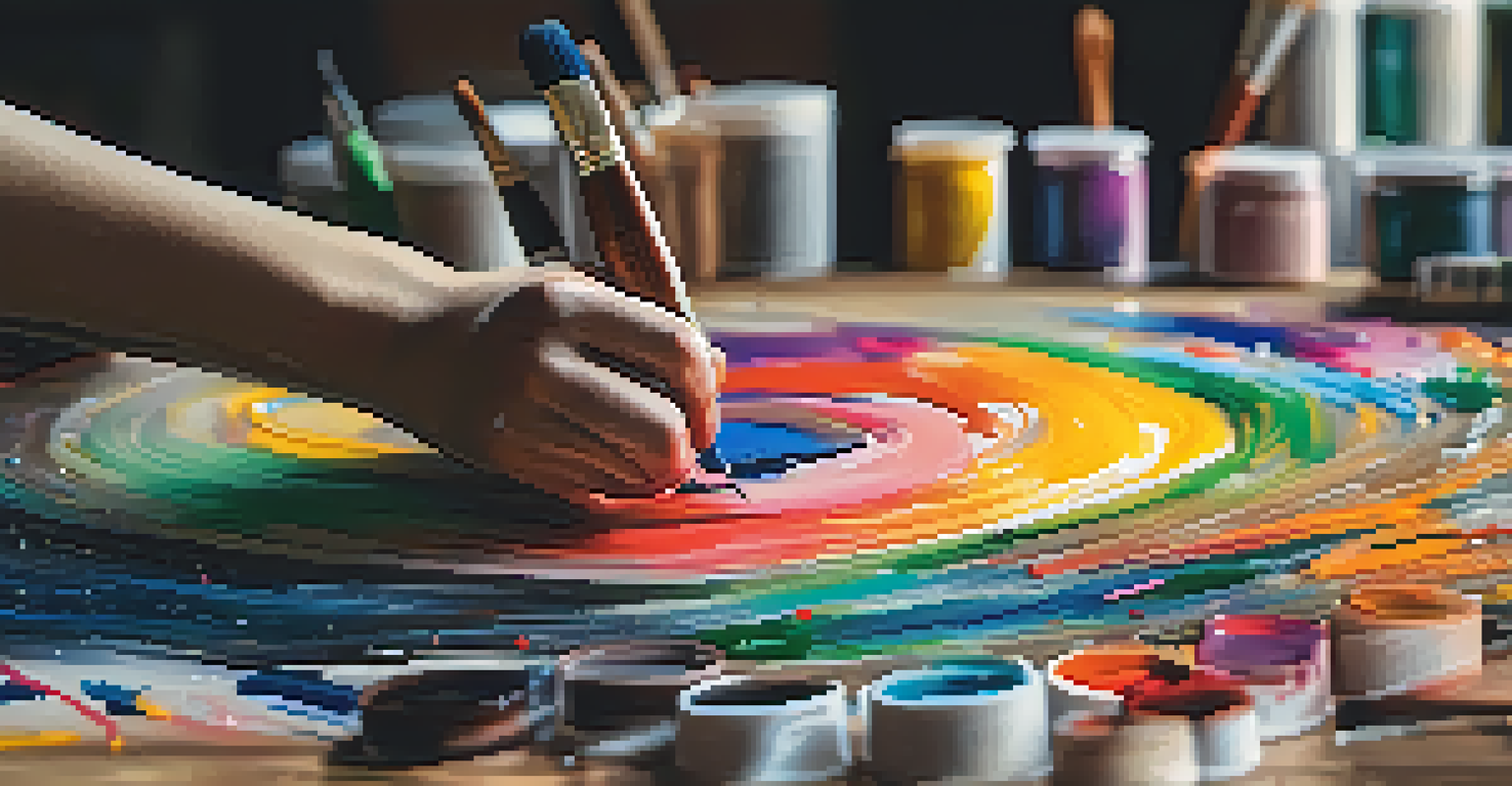The Concept of Authenticity in Art: Historical Perspectives

Understanding Authenticity: A Definition in Art
At its core, authenticity in art refers to the genuineness of a piece, encompassing both its origin and the intent behind its creation. It’s about whether a work truly represents the artist’s vision or if it’s merely a reproduction or imitation. The concept can be complex, as it intertwines with ideas of originality, authorship, and cultural context.
Art is the most beautiful of all lies.
For instance, when we consider a painting by Van Gogh, authenticity not only pertains to its physical presence but also to the emotional and historical narrative it carries. This brings us to the notion that authenticity can be subjective, shaped by our perceptions and the cultural lenses through which we view art. It’s a dance between what is real and what is perceived, making it a fascinating topic of exploration.
As we delve deeper into art history, we’ll discover how various movements and eras have shaped and redefined what authenticity means. From the Renaissance's emphasis on individual genius to modern interpretations of cultural appropriation, the concept has evolved significantly, revealing much about societal values and artistic expression.
Ancient Perspectives on Authenticity in Art
In ancient civilizations, authenticity was often tied to divine inspiration. Artists were seen as vessels through which gods communicated, thus their works were considered authentic if they aligned with this spiritual vision. For example, in ancient Greece, the authenticity of a sculpture was closely linked to its ability to evoke the divine qualities of the subjects depicted.

Moreover, the use of materials and techniques also played a crucial role in determining authenticity. The Greeks valued marble and bronze, believing that the choice of medium could either elevate or diminish the work’s authenticity. A statue crafted from inferior materials might have been viewed as less genuine, regardless of the skill employed in its creation.
Authenticity Intertwines with Intent
The authenticity of art goes beyond its physical form, incorporating the artist's intent and the cultural context within which it is created.
This ancient understanding of authenticity laid vital groundwork for future artistic philosophies. It highlights how, even in early art, the tension between material, intention, and perception was already at play, setting the stage for ongoing discussions about what it means for art to be 'authentic.'
Renaissance: The Birth of Individual Artistic Identity
The Renaissance marked a significant shift in the concept of authenticity, as artists began to emerge as individual creators rather than mere craftsmen. Figures like Leonardo da Vinci and Michelangelo championed the idea of artistic genius, where authenticity was tied to personal vision and mastery. This era celebrated originality, with artists striving to capture the unique essence of their subjects.
Every artist dips his brush in his own soul, and paints his own nature into his pictures.
During this time, the practice of signing artworks became more common, serving as a declaration of authenticity. A signature was not just a name but a stamp of the artist’s identity, a promise to the viewer that the work was a true reflection of their creative intent. This newfound emphasis on the individual artist transformed the landscape of art, intertwining authenticity with personal branding.
As a result, the Renaissance laid the foundations for modern concepts of authenticity, framing the artist's intent as crucial to understanding a work. This shift invites us to consider how authenticity continues to evolve in contemporary art, where the artist's story and identity often play a pivotal role in how their work is perceived.
The Enlightenment and the Rise of Critical Theory
The Enlightenment brought about a wave of philosophical inquiry that challenged established norms, including ideas about artistic authenticity. Thinkers like Kant argued that true art must transcend mere imitation and evoke a sense of beauty and truth. This period prompted a deeper examination of what constitutes authenticity in art, emphasizing not just the artist’s intent but also the viewer's experience.
Critics began to evaluate artworks through a lens of rationality, questioning the authenticity of pieces based on their adherence to classical standards and emotional impact. This critical perspective shifted the focus from the artist alone to the relationship between the artist, artwork, and audience, enriching the dialogue surrounding authenticity.
Cultural Exchange Shapes Authenticity
In today's globalized world, the complexities of cultural appropriation and representation challenge traditional notions of authenticity in art.
As a result, the Enlightenment period highlighted the complexities of authenticity, suggesting that it is not only about the creator but also about the context in which the art is experienced. This interplay continues to influence contemporary discussions, reminding us that authenticity is often a collaborative construct involving multiple voices and perspectives.
Romanticism: Emotion and Authenticity in Art
The Romantic movement of the late 18th and early 19th centuries celebrated individual emotion and imagination, further complicating the notion of authenticity in art. Artists like Turner and Delacroix sought to express their inner feelings and personal experiences, positioning authenticity as a reflection of emotional truth rather than mere technical skill. This shift made the artist's emotional state a vital component of the authenticity debate.
Romanticism encouraged artists to break free from traditional forms and experiment with new styles, which further blurred the lines of authenticity. The emphasis on personal expression meant that what was once considered 'authentic' could now vary widely based on the individual artist's emotional landscape. This newfound freedom sparked a broader conversation about whether authenticity lies in adherence to tradition or in the exploration of personal narrative.
Ultimately, Romanticism redefined authenticity, urging us to consider the impact of emotion in artistic creation. It invites us to reflect on how our own feelings shape our understanding of art, reminding us that authenticity can be both subjective and deeply personal.
Modernism: Challenging Traditional Notions of Authenticity
With the rise of Modernism in the late 19th and early 20th centuries, the concept of authenticity faced new challenges. Artists like Picasso and Duchamp pushed boundaries, questioning what art could be and, in turn, what authenticity meant. Duchamp's 'Fountain,' a ready-made artwork, forced audiences to reconsider their perceptions of originality and authenticity, suggesting that context and intention could redefine a piece's value.
This era saw a departure from the idea that authenticity relied solely on craftsmanship and individual genius. Instead, Modernists proposed that a work's authenticity could emerge from concepts, ideas, and the act of creation itself. This radical shift opened the door for diverse interpretations of authenticity, emphasizing the importance of cultural and social contexts.
Modernism Redefines Authenticity
Modernism shifted the focus from craftsmanship to concepts, allowing for diverse interpretations of authenticity based on context and intention.
Modernism's impact on the authenticity debate continues to resonate in contemporary art. It encourages us to think critically about how authenticity is constructed and perceived in a world where replication and reinterpretation are commonplace, challenging us to find value in the dialogue between the original and the reproduced.
Contemporary Views on Authenticity in Art
Today, the concept of authenticity in art is more layered than ever. In a globalized world where cultural exchange is integral, the question of who can claim authenticity becomes complex. Issues of cultural appropriation and representation urge artists and audiences to navigate the fine line between inspiration and exploitation, prompting ongoing discussions about what it means to be 'authentic.'
Furthermore, advancements in technology have transformed the art landscape, raising questions about digital authenticity. As art becomes increasingly digitized, how do we determine the authenticity of a piece created or altered by algorithms? This phenomenon challenges traditional notions and invites fresh perspectives on the role of the artist in a digital age.

Ultimately, contemporary views on authenticity reflect a tapestry of voices and experiences. They encourage us to embrace ambiguity and complexity, reminding us that authenticity is a dynamic concept that evolves alongside society, culture, and technology, remaining as vital today as it has been throughout history.